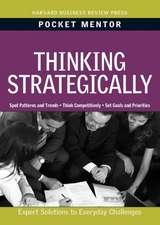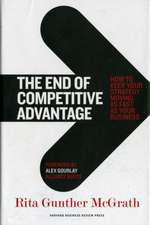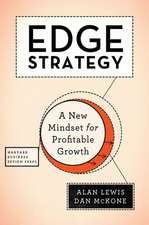The Essential Advantage: How to Win with a Capabilities-Driven Strategy
Autor Paul Leinwand, Cesare R. Mainardien Limba Engleză Hardback – 9 dec 2010
Conventional wisdom on strategy is no longer a reliable guide. In Essential Advantage, Booz & Company's Cesare Mainardi and Paul Leinwand maintain that success in any market accrues to firms with coherence: a tight match between their strategic direction and the capabilities that make them unique.
Achieving this clarity takes a sharpness of focus that only exceptional companies have mastered. This book helps you identify your firm's blend of strategic direction and distinctive capabilities that give it the "right to win" in its chosen markets. Based on extensive research and filled with company examples—including Amazon.com, Johnson & Johnson, Tata Sons, and Procter & Gamble—Essential Advantage helps you construct a coherent company in which the pieces reinforce each other instead of working at cross-purposes.
The authors reveal:
· Why you should focus on a system of a few aligned capabilities
· How to identify the "way to play" in your market
· How to design a strategy for well-modulated growth
· How to align a portfolio of businesses behind your capability system
· How your strategy clarifies growth, costs, and people decisions
Few companies achieve a capability-driven "right to win" in their market. This book helps you position your firm to be among them.
Achieving this clarity takes a sharpness of focus that only exceptional companies have mastered. This book helps you identify your firm's blend of strategic direction and distinctive capabilities that give it the "right to win" in its chosen markets. Based on extensive research and filled with company examples—including Amazon.com, Johnson & Johnson, Tata Sons, and Procter & Gamble—Essential Advantage helps you construct a coherent company in which the pieces reinforce each other instead of working at cross-purposes.
The authors reveal:
· Why you should focus on a system of a few aligned capabilities
· How to identify the "way to play" in your market
· How to design a strategy for well-modulated growth
· How to align a portfolio of businesses behind your capability system
· How your strategy clarifies growth, costs, and people decisions
Few companies achieve a capability-driven "right to win" in their market. This book helps you position your firm to be among them.
Preț: 198.00 lei
Nou
Puncte Express: 297
Preț estimativ în valută:
37.90€ • 41.18$ • 31.86£
37.90€ • 41.18$ • 31.86£
Carte disponibilă
Livrare economică 31 martie-14 aprilie
Preluare comenzi: 021 569.72.76
Specificații
ISBN-13: 9781422136515
ISBN-10: 1422136515
Pagini: 240
Ilustrații: Illustrations
Dimensiuni: 156 x 235 x 25 mm
Greutate: 0.43 kg
Editura: Harvard Business Review
Colecția Harvard Business Review Press
Locul publicării:United States
ISBN-10: 1422136515
Pagini: 240
Ilustrații: Illustrations
Dimensiuni: 156 x 235 x 25 mm
Greutate: 0.43 kg
Editura: Harvard Business Review
Colecția Harvard Business Review Press
Locul publicării:United States
Cuprins
Chapter Page
1 The Value of Coherence: Essential advantage and what it means for your business
2 The Elements of Strategy: Achieving a balance between your way to play, capability system and product and service portfolio
3 The Journey to Coherence: What to expect from a capabilities-driven strategy
4 Headroom for Growth: Leveraging capabilities to expand in your chosen markets
5 The Capabilities-Driven Deal-Maker: Why essential advantage matters in mergers, acquisitions and divestitures
6 Changing the Conversation About Costs: Expense ,management through a capabilities lens
7 Building Capability Systems: Assembling the right people and organization to support coherence
8 Living Coherence Every Day: Mobilizing the formal and informal organization for essential advantage
9 How to Develop a Capabilities-Driven Strategy: A four-step process for achieving coherence
10 The Capable Leader
Appendix 1 Measuring Coherence: Notes on our research
1 The Value of Coherence: Essential advantage and what it means for your business
2 The Elements of Strategy: Achieving a balance between your way to play, capability system and product and service portfolio
3 The Journey to Coherence: What to expect from a capabilities-driven strategy
4 Headroom for Growth: Leveraging capabilities to expand in your chosen markets
5 The Capabilities-Driven Deal-Maker: Why essential advantage matters in mergers, acquisitions and divestitures
6 Changing the Conversation About Costs: Expense ,management through a capabilities lens
7 Building Capability Systems: Assembling the right people and organization to support coherence
8 Living Coherence Every Day: Mobilizing the formal and informal organization for essential advantage
9 How to Develop a Capabilities-Driven Strategy: A four-step process for achieving coherence
10 The Capable Leader
Appendix 1 Measuring Coherence: Notes on our research
Recenzii
Named by strategy+business magazine as one of the Best Business Books of 2011.
“Few companies achieve a capabilities-driven “right to win” in their markets. This book will help your firm be among them.” - Consulting Magazine
“Few companies achieve a capabilities-driven “right to win” in their markets. This book will help your firm be among them.” - Consulting Magazine
Notă biografică
Paul Leinwand is a Partner in Booz & Company's global consumer, media, and retail practice. He serves as chair of the firm's Marketing Advisory Council. Cesare Mainardi is Managing Director of Booz & Company's North American business and is a member of the firm's Executive Committee. In 2005, Consulting magazine named him in its Top 25 Consultants list.
Extras
Chapter 1: The Value of Coherence
Essential advantage and what it means for your business
How many books, frameworks, and consultants have you turned to in the search for the right strategy? How often have your strategies changed in an attempt to create value? How many times has your organization pursued new growth avenues or “white spaces”, with an enormous amount of time and effort, and never quite getting the results you expected? How many initiatives have you started that didn’t stick – or that never achieved their potential?
Most importantly, how many of these approaches to business success were isolated or fragmented within your company, ignoring or even undermining each other, simply because nobody had quite figured out how to fit them all together?
“We’re searching for the glue,” lamented the CEO of one of the world’s largest consumer products companies when we met with him not long ago. He is not alone. Most senior executives would like their decisions to relate effectively to all parts of the enterprise, from customers to internal investments to product or service lines. And yet they seem to spend their time making choices and tradeoffs, balancing functional requests with business demands, all while putting out the fires that flare up constantly. They don’t spend a lot of time on the potential advantage available to the enterprise as a whole.
This is a book about the nature of essential advantage in any business. As strategy consultants who have worked with hundreds of companies in defining moments of crisis and business transformation, we’ve been furnished with a rare window on what allows organizations to establish and sustain success over time. As a result, we have distilled what we believe to be the essence of advantage.
Your essential advantage is what your company does better than anyone else. When it is relevant to your ability to create value, it becomes the source of sustainable, superior returns. It’s not what you have that matters; it’s not what you sell; it’s not even what you’re known for. It’s what you do, time and again, for the customers you serve.
Many businesses struggle along without a clearly realized, distinctive advantage of this sort, But a few seem to possess it to some noticeable degree. These are the companies whose people, from the top to the bottom of the hierarchy, seem to know what they are doing and why. These companies manage to set priorities among competing demands, unsentimentally cutting out operations and activities that don’t fit, and yet they are gracious and responsible where it counts. When they enter a new market or launch a new product, they do so confidently, as if they have earned the right to win. They often seem one step ahead, outpacing competitors and anticipating just what their customers will want next, while making it all look natural. And their products and services are enviably profitable Even the atmosphere in their offices somehow conveys focus and clear thinking. (Yes, they make missteps – but those are often quickly forgotten in the context of their overall success. They may even learn from them.) If you look closely at how they operate, you won’t find any sign of the false distinction between strategy and execution that holds so many companies back.
These qualities are not random or anomalous. They stem directly from being coherent.
To most businesses, coherence simply means a requisite degree of shared resources and consensus. But to us, it is much more rigorous and specific. Coherence is resolute focus and clarity around the way a company creates value in the market. It created by bringing together three critical elements of strategy, the elements that set the direction for any commercial enterprise:
• The “way to play:” a company’s deliberately chosen way to create value in the market for its chosen customers.
• The “capability system:” The integrated collection of processes and practices that a company deploys to fulfill its way to play.
• The “product and service fit:” The portfolio of offerings that make good use of the capability system.
Only a coherent company – one which has mastered this three-part balancing act – is equipped to reliably, sustainably, outpace competitors. The essential advantage that results from this coherence is also linked, as we will see throughout this book, to higher effectiveness, superior economics, and sustained gains in financial performance, which together generate significant shareholder value.
In fact, we contend that, in most industries, coherence is the only route available for a company that wants to develop a right to win in its markets; the only way to create enduring value for shareholders and employees. The details of any company’s coherence – its preferred ways to play, capabilities, and portfolio of products and services -- will vary enormously from one company to the next, but the overall principle remains constant: Coherence is the only sustainable source of essential advantage.
Our core insight is that simple. Yet it is incredibly hard for companies to internalize and for external stakeholders (such as Wall Street) to support.
Most companies fail to pass the test of coherence. Their functional agendas and business priorities collide. Their growth emanates not from the core but the acquisition of apparent “adjacencies” and “synergies” that often turn out to be anything but adjacent or synergistic. When they cut costs—which they must do more often than they should—it is an across-the-board exercise rather than a considered reallocation of resources.
Although few companies are fully coherent, many companies thrive because they are relatively coherent, compared to their competitors. Once business people grasp the value of coherence (and the essential advantage it can provide them), they become far more effective than they had been before. And any company, no matter how difficult its industry or circumstances, can turn away from incoherence at any time.
The pursuit of essential advantage is powerfully rewarding. But it requires courage to make the necessary choices, and stamina and skill to execute them, even for the most experienced leaders. Above all, it requires continuous attention. Every choice a CEO or business manager will face, from M&A decisions to organizational issues, will now be made from a coherence-related perspective.
Let’s see what happens when a company takes on this challenge – with a start-to-finish case study of the way a division of Pfizer gained essential advantage through a deliberate set of strategic decisions.
Essential advantage and what it means for your business
How many books, frameworks, and consultants have you turned to in the search for the right strategy? How often have your strategies changed in an attempt to create value? How many times has your organization pursued new growth avenues or “white spaces”, with an enormous amount of time and effort, and never quite getting the results you expected? How many initiatives have you started that didn’t stick – or that never achieved their potential?
Most importantly, how many of these approaches to business success were isolated or fragmented within your company, ignoring or even undermining each other, simply because nobody had quite figured out how to fit them all together?
“We’re searching for the glue,” lamented the CEO of one of the world’s largest consumer products companies when we met with him not long ago. He is not alone. Most senior executives would like their decisions to relate effectively to all parts of the enterprise, from customers to internal investments to product or service lines. And yet they seem to spend their time making choices and tradeoffs, balancing functional requests with business demands, all while putting out the fires that flare up constantly. They don’t spend a lot of time on the potential advantage available to the enterprise as a whole.
This is a book about the nature of essential advantage in any business. As strategy consultants who have worked with hundreds of companies in defining moments of crisis and business transformation, we’ve been furnished with a rare window on what allows organizations to establish and sustain success over time. As a result, we have distilled what we believe to be the essence of advantage.
Your essential advantage is what your company does better than anyone else. When it is relevant to your ability to create value, it becomes the source of sustainable, superior returns. It’s not what you have that matters; it’s not what you sell; it’s not even what you’re known for. It’s what you do, time and again, for the customers you serve.
Many businesses struggle along without a clearly realized, distinctive advantage of this sort, But a few seem to possess it to some noticeable degree. These are the companies whose people, from the top to the bottom of the hierarchy, seem to know what they are doing and why. These companies manage to set priorities among competing demands, unsentimentally cutting out operations and activities that don’t fit, and yet they are gracious and responsible where it counts. When they enter a new market or launch a new product, they do so confidently, as if they have earned the right to win. They often seem one step ahead, outpacing competitors and anticipating just what their customers will want next, while making it all look natural. And their products and services are enviably profitable Even the atmosphere in their offices somehow conveys focus and clear thinking. (Yes, they make missteps – but those are often quickly forgotten in the context of their overall success. They may even learn from them.) If you look closely at how they operate, you won’t find any sign of the false distinction between strategy and execution that holds so many companies back.
These qualities are not random or anomalous. They stem directly from being coherent.
To most businesses, coherence simply means a requisite degree of shared resources and consensus. But to us, it is much more rigorous and specific. Coherence is resolute focus and clarity around the way a company creates value in the market. It created by bringing together three critical elements of strategy, the elements that set the direction for any commercial enterprise:
• The “way to play:” a company’s deliberately chosen way to create value in the market for its chosen customers.
• The “capability system:” The integrated collection of processes and practices that a company deploys to fulfill its way to play.
• The “product and service fit:” The portfolio of offerings that make good use of the capability system.
Only a coherent company – one which has mastered this three-part balancing act – is equipped to reliably, sustainably, outpace competitors. The essential advantage that results from this coherence is also linked, as we will see throughout this book, to higher effectiveness, superior economics, and sustained gains in financial performance, which together generate significant shareholder value.
In fact, we contend that, in most industries, coherence is the only route available for a company that wants to develop a right to win in its markets; the only way to create enduring value for shareholders and employees. The details of any company’s coherence – its preferred ways to play, capabilities, and portfolio of products and services -- will vary enormously from one company to the next, but the overall principle remains constant: Coherence is the only sustainable source of essential advantage.
Our core insight is that simple. Yet it is incredibly hard for companies to internalize and for external stakeholders (such as Wall Street) to support.
Most companies fail to pass the test of coherence. Their functional agendas and business priorities collide. Their growth emanates not from the core but the acquisition of apparent “adjacencies” and “synergies” that often turn out to be anything but adjacent or synergistic. When they cut costs—which they must do more often than they should—it is an across-the-board exercise rather than a considered reallocation of resources.
Although few companies are fully coherent, many companies thrive because they are relatively coherent, compared to their competitors. Once business people grasp the value of coherence (and the essential advantage it can provide them), they become far more effective than they had been before. And any company, no matter how difficult its industry or circumstances, can turn away from incoherence at any time.
The pursuit of essential advantage is powerfully rewarding. But it requires courage to make the necessary choices, and stamina and skill to execute them, even for the most experienced leaders. Above all, it requires continuous attention. Every choice a CEO or business manager will face, from M&A decisions to organizational issues, will now be made from a coherence-related perspective.
Let’s see what happens when a company takes on this challenge – with a start-to-finish case study of the way a division of Pfizer gained essential advantage through a deliberate set of strategic decisions.









